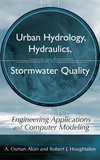Urban Hydrology, Hydraulics, and Stormwater Quality: Engineering Applications and Computer ModelingISBN: 978-0-471-43158-9
Hardcover
392 pages
August 2003
 This is a Print-on-Demand title. It will be printed specifically to fill your order. Please allow an additional 10-15 days delivery time. The book is not returnable.
|
||||||
Acknowledgments.
1 Introduction.
1.1 Urbanization and Stormwater Runoff.
1.2 Urban Hydrology, Hydraulics, and Stormwater Quality.
1.3 Organization of the Book.
Problems.
2 Rainfall for Designing Urban Drainage Systems.
2.1 Hydrologic Description of Rainfall.
2.2 Probabilistic Description of Rainfall.
2.2.1 Return Period and Hydrologic Risk.
2.2.2 Frequency Analysis.
2.2.3 Intensity-Duration-Return Period Curves.
2.2.4 Mathematical Intensity-Duration Relationships.
2.3 Design Rainfall.
2.3.1 Continuous Simulation and Single-Event Methods.
2.3.2 Design Return Period.
2.3.3 Design-Storm Duration and Depth.
2.3.4 Spatial and Temporal Distribution of Design Rainfall.
2.4 Construction of Design-Storm Hyetographs.
2.4.1 Soil Conservation Service Method.
2.4.2 Yen and Chow Method.
2.4.3 Huff Method.
2.4.4 Synthetic Block Hyetograph Method.
2.4.5 Chicago Method.
Problems.
References.
3 Rainfall Excess Calculations.
3.1 Calculation of Rainfall Abstractions.
3.1.1 Interception Storage.
3.1.2 Infiltration.
3.1.3 Depression Storage.
3.2 Combined Loss Models.
3.2.1 Soil Conservation Service Method.
3.2.2 Other Combined Loss Models.
Problems.
References.
4 Rainfall Excess and Open-Channel Flow in Urban Watersheds.
4.1 Open-Channel Hydraulics.
4.1.1 Basic Definitions.
4.1.2 States of Open-Channel Flow.
4.1.3 Open-Channel Flow Equations.
4.1.4 Steady Gradually Varied Flow.
4.1.5 Normal Flow.
4.1.6 Open-Channel Rating Curve.
4.2 Overland Flow.
4.2.1 Kinematic-Wave Model.
4.2.2 Overland Flow on Impervious Surfaces.
4.2.3 Overland Flow on Pervious Surfaces.
4.3 Channel Flow.
4.3.1 Muskingum Method.
4.3.2 Muskingum-Cunge Method.
4.3.3 Muskingum-Cunge Method for Routing with Lateral Inflow.
4.3.4 Modified Att-Kin Method.
Problems.
References.
5 Calculation of Runoff Rates From Urban Watersheds.
5.1 Basic Concepts.
5.1.1 Elements of Urban Runoff Hydrographs.
5.1.2 Definition of Time of Concentration.
5.2 Calculation of Time of Concentration.
5.2.1 SCS Time-of-Concentration Method.
5.2.2 Kinematic Time-of-Concentration Formulas.
5.2.3 Kirpich Formula.
5.3 Unit Hydrograph Method.
5.3.1 Unit Hydrograph Development.
5.3.2 Application of the Unit Hydrograph Method.
5.4 Soil Conservation ServiceMethods for Runoff Rate Calculations.
5.4.1 TR-55 Graphical Peak Discharge Method.
5.4.2 TR-55 Tabular Hydrograph Method.
5.5 The Santa Barbara Urban Hydrograph Method.
5.6 USGS Regression Equations.
5.7 The Rational Method.
5.8 The Kinematic-Rational Methods.
Problems.
References.
6 Stormwater Drainage Structures.
6.1 Drainage of Street Pavements.
6.1.1 General Design Considerations.
6.1.2 Flow in Gutters.
6.1.3 Pavement Drainage Inlets.
6.1.4 Pavement Drainage Inlet Locations.
6.2 Storm Sewer Systems.
6.2.1 Storm Sewer Hydraulics.
6.2.2 Design Discharge for Storm Sewers.
6.2.3 Sizing Storm Sewers.
6.2.4 Hydraulic Grade Line Considerations.
6.2.5 Storm Sewer System Design Calculations.
6.3 Culverts.
6.3.1 Inlet Control Flow.
6.3.2 Outlet Control Flow.
6.3.3 Sizing of Culverts.
6.4 Design of Surface Drainage Channels.
6.4.1 Design of Unlined Channels.
6.4.2 Design of Grass-Lined Channels.
Problems.
References.
Suggested Reading.
7 Stormwater Detention for Quantity Management.
7.1 Detention Basins.
7.1.1 Stage-Storage Relationship.
7.1.2 Stage-Discharge Relationship.
7.1.3 Pond Routing.
7.1.4 Pond-Routing Charts.
7.1.5 Design of Detention Basins.
7.2 Infiltration Practices.
7.2.1 Capture Volume.
7.2.2 Soil Textures.
7.2.3 Infiltration Basins.
7.2.4 Infiltration Trenches.
7.2.5 Dry Wells.
7.2.6 Porous Pavements.
Problems.
References.
Suggested Reading.
8 Urban Stormwater Pollution.
8.1 Modeling Urban Stormwater Quality.
8.1.1 Solids Buildup and Wash-off from Impervious Areas.
8.1.2 Solids Wash-off from Pervious Surfaces.
8.1.3 Wash-off of Pollutants Other than Solids.
8.1.4 Pollutographs and Loadographs.
8.2 Annual Pollutant Load Estimates.
8.2.1 EPA Model for Annual Pollutant Loading Estimation.
8.2.2 U.S. Geological Survey Model for Mean Annual Loads.
8.2.3 Metropolitan Washington Council of Governments Method.
Problems.
References.
9 Best Management Practices for Urban Stormwater Quality Control.
9.1 Extended Detention Basins.
9.1.1 Sizing Extended Detention Basins.
9.1.2 Sizing Water Quality Outlet Devices.
9.1.3 Additional Extended Detention Basin Design Considerations.
9.2 Retention Basins.
9.2.1 Permanent Pool Volume.
9.2.2 Retention Basin Design Considerations.
9.2.3 EPA Methodology for Analysis of Wet Pond Detention Basins.
9.3 Water Quality Trenches.
9.4 Sand Filters.
9.5 Stormwater Wetlands.
9.6 Other Vegetative BMPs.
9.6.1 Grass Swales.
9.6.2 Filter Strips.
9.7 The National Stormwater BMP Database.
Problems.
References.
10 Urban Stormwater Computer Models: HEC-HMS and EPA-SWMM.
10.1 Hydrologic Modeling Overview and Watershed Delineation.
10.2 Model Structure and Features of HEC-HMS.
10.3 Technical Capabilities of HEC-HMS.
10.4 HEC-HMS Example Problem.
10.5 Structure and Features of EPA-SWMM.
10.6 Technical Capabilities of EPA-SWMM.
10.7 EPA-SWMM Example Problem.
10.8 Model Calibration and Verification.
Problems.
References.
Suggested Reading.
Appendix 1: Tabular Hydrograph Unit Discharges for SCS Type II Rainfall Distribution.
Index.



